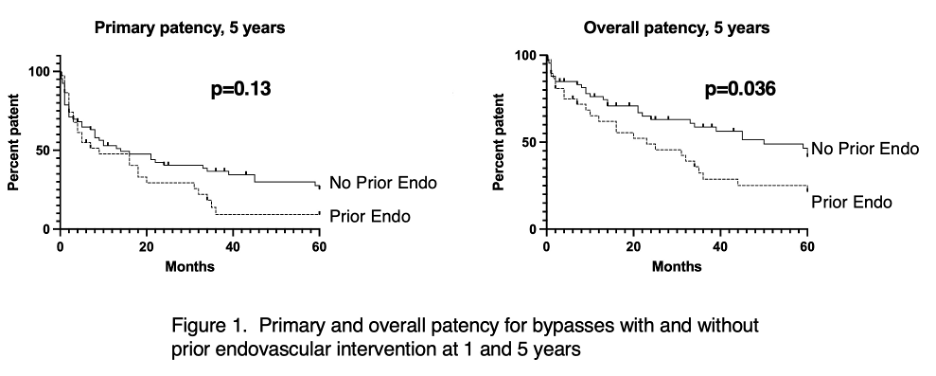OBJECTIVES: The use of arm vein as an alternative conduit in patients undergoing lower extremity bypass (LEB) has acceptable patency and limb salvage rates. However, these studies predate the endovascular era. This study examines the effect of prior endovascular therapy on patency and outcomes of LEB utilizing arm vein conduit. METHODS: All patients who underwent LEB with arm vein conduit between 2006-2020 at a single academic institution were included. Patients were grouped into those with prior endovascular intervention versus those with a bypass-first approach. Demographics, comorbidities and operative characteristics were compared. Patency was assessed using Kaplan-Meier survival analysis. RESULTS: 107 patients who underwent LEB with arm vein were included: 40 had prior endovascular intervention (median age 67 years, 73% male), and 67 underwent bypass first (median age 68 years, 72% male). There were no significant differences in co-morbidities between the two groups except hypertension (prior endo: 75% vs bypass first: 90%, p=0.046). Pre-operative aspirin use was higher in those patients who underwent prior endovascular intervention (90% vs 70%, p=0.017). Basilic vein was the most used vein (66.4%), followed by cephalic (50.5%). 46.7% of patients had at least one venovenostomy (54% vs 38%, p=0.08). With mean follow up of 34.7 months the primary patency was not statistically different, Figure 1A, but 5 year secondary patency was higher in the bypass first group (41.6% vs 21.5%, p=0.036; Figure 1B). Those with a pedal target had lower overall patency at 5 years (non-pedal: 42.8% vs pedal: 13.1%, p=0.025). Major amputation risk did not reach statistical significance (prior endo: 22.5% vs 8.9%, p=0.06). There were no differences in wound complications (27.1% overall), post-operative length of stay (5.9 days overall) or re-intervention (36.4% overall). CONCLUSIONS: Arm vein is an acceptable alternative for use in LEB when saphenous vein is not available, even when spliced. Those performed after prior endovascular intervention may be at risk of decreased patency. Overall patency was higher in those patients without prior endovascular intervention. 